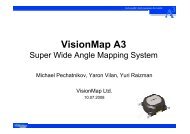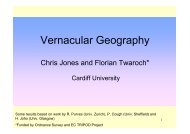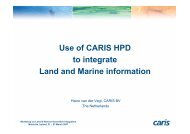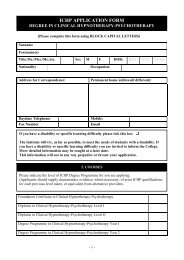EuroSDR Projects - Host Ireland
EuroSDR Projects - Host Ireland
EuroSDR Projects - Host Ireland
Create successful ePaper yourself
Turn your PDF publications into a flip-book with our unique Google optimized e-Paper software.
3 Test Data and Evaluation Criteria<br />
Initially, eight test images were prepared from different sensors (for details see the README file in<br />
Appendix 5):<br />
• 3 scanned aerial images from the Federal Office of Topography, Bern, Switzerland<br />
• Aerial1: suburban area in hilly terrain<br />
• Aerial2: rural scene with medium complexity in hilly terrain<br />
• Aerial3: rural scene with low complexity in hilly terrain<br />
• 2 Leica ADS40 images from Leica Geosystems, Heerbrugg, Switzerland<br />
• ADS40_1 and _2: rural area with medium complexity in flat terrain.<br />
• 3 IKONOS images from Kosovo, provided by Bundeswehr Geoinformation Office (AGeoBw),<br />
Euskirchen, Germany, given as pan sharpened images in red, green, blue, and infrared<br />
• Ikonos1: urban/suburban area in hilly terrain<br />
• Ikonos2: rural scene with medium complexity in hilly terrain<br />
• Ikonos3: rural scene with medium complexity in hilly terrain<br />
All images have a size of at least 4,000 by 4,000 pixels. While we initially thought that this size<br />
should be a challenge that people should be able to overcome during the duration of the test, it was<br />
finally found to be insurmountable by nearly all approaches even two years after the envisaged end of<br />
the test and, therefore, the limiting factor of the test. We, therefore, decided eventually to cut out three<br />
smaller parts with 1,600 by 1,600 pixels of the Ikonos images, one from Ikonos1 and two from<br />
Ikonos3, as there seemed to be most interest in this area.<br />
For evaluation we use criteria put forward by Wiedemann et al. (1998). The basic assumption is that<br />
reference data is available in the form of the center lines of the roads. Additionally, it is assumed that<br />
only roads within a buffer of a certain width, usually the average width of the roads, around the road<br />
are correct. The extracted roads which are inside the buffer of the given reference roads and vice versa<br />
are determined via matching of the respective vector data. The most important criteria defined by<br />
Wiedemann et al. (1998) based on these matching results to which we have restricted the analysis are:<br />
Completeness: This is the percentage of the reference data which is explained by the extracted data,<br />
i.e., the part (percentage) of the reference network which lies within the buffer around the extracted<br />
data. The optimum value for the completeness is 1.<br />
Correctness: It represents the percentage of correctly extracted road data, i.e., the percentage of the<br />
extracted data which lie within the buffer around the reference network. The optimum value for the<br />
correctness is 1.<br />
RMS (root mean square): The RMS error expresses the geometrical accuracy of the extracted road<br />
data around the reference network. In the given evaluation framework its value depends on the buffer<br />
width. If an equal distribution of the extracted road data within the buffer around the reference<br />
network is assumed, it can be shown that RMS equals one divided by square root 3 of the buffer<br />
width. The optimum value for RMS is 0. As RMS mainly depends on the resolution of the image, it is<br />
given in pixels in this report.<br />
The reference data has an estimated precision of half a pixel. It comprises major and secondary roads,<br />
but no paths or short driveways. The reference data has not been made available to the participants.<br />
The participants usually asked only once or twice for an evaluation, i.e., no optimization in terms of<br />
the reference data was pursued. Opposed to (Scharstein and Szeliski, 2002) we allowed people to<br />
225









